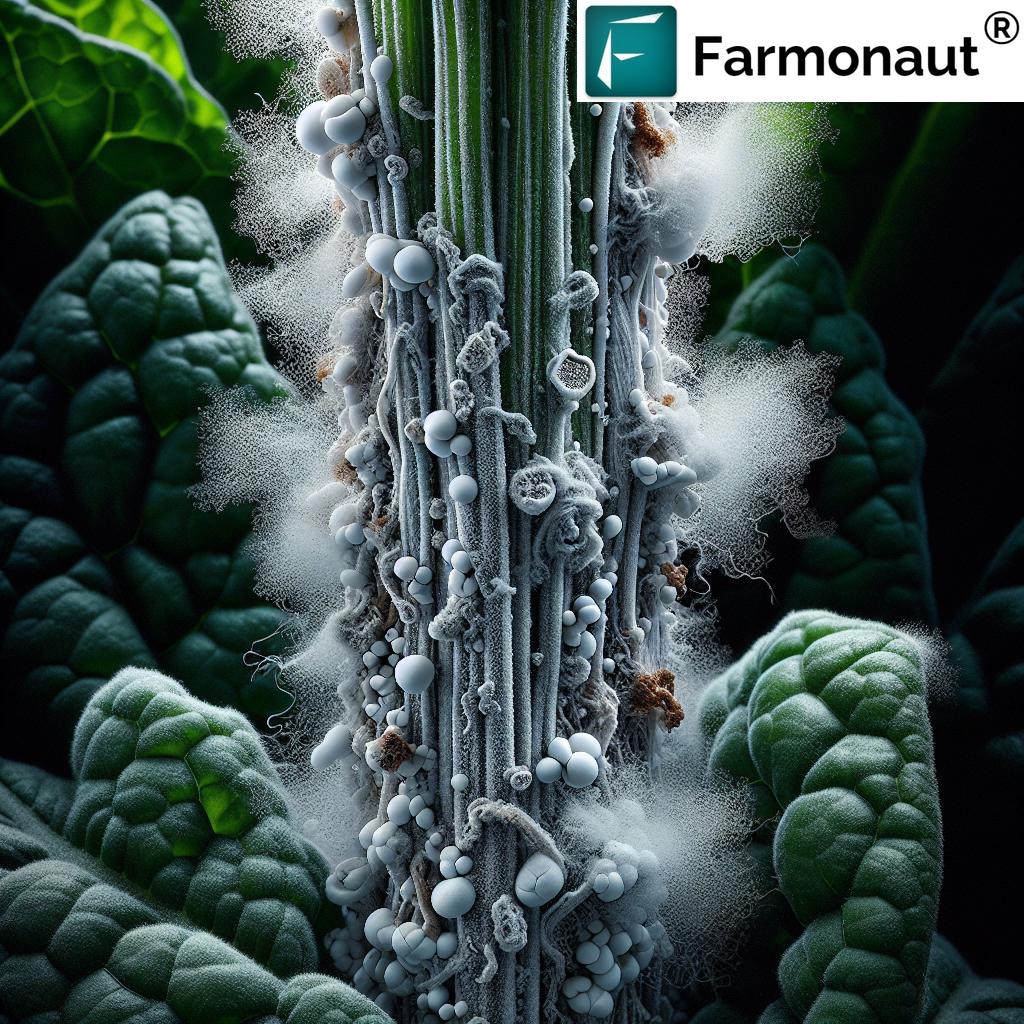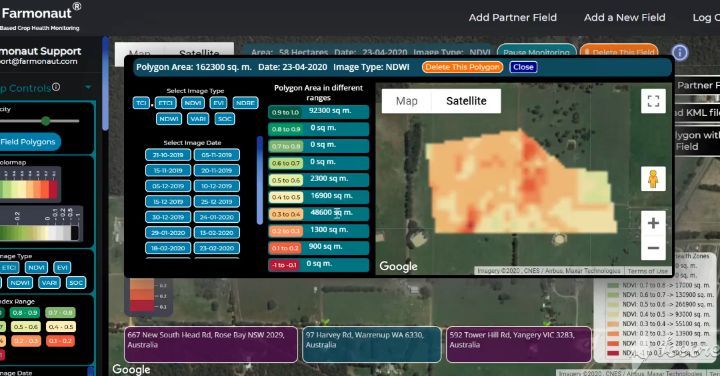Mastering Sclerotinia Control: Organic and Chemical Measures for Healthy Crop Growth

In the ever-evolving world of agriculture, we at Farmonaut understand the critical importance of managing crop diseases effectively. One such challenging disease that farmers often face is Sclerotinia, caused by the fungus Sclerotinia sclerotiorum. This devastating pathogen can wreak havoc on a wide range of crops, leading to significant yield losses if left unchecked. In this comprehensive guide, we’ll delve deep into the world of Sclerotinia control, exploring both organic and chemical measures to ensure healthy crop growth.
Understanding Sclerotinia: The Silent Crop Killer
Sclerotinia, often referred to as white mold, is a formidable foe in the agricultural world. The fungus Sclerotinia sclerotiorum is the culprit behind this disease, known for its ability to survive in soil for extended periods through hardened structures called sclerotia. These sclerotia serve as the primary inoculum source, capable of germinating under favorable conditions and initiating new infections.
The Life Cycle of Sclerotinia sclerotiorum
- Survival in Soil: Sclerotia can persist in soil for several years, waiting for the right conditions to strike.
- Germination: Under high humidity and cool temperatures, sclerotia germinate to produce apothecia (mushroom-like structures).
- Spore Release: Apothecia release ascospores into the air, which can travel long distances.
- Infection: Spores land on susceptible plant tissues, particularly during flowering stages.
- Mycelial Growth: The fungus develops a network of mycelium within plant tissues.
- Symptom Development: Infected plants show water-soaked lesions, wilting, and characteristic white, fluffy mold growth.
- Sclerotia Formation: New sclerotia form within infected plant tissues, completing the cycle.
The Impact of Sclerotinia on Crop Health and Yield
Sclerotinia can affect a wide range of crops, including:
- Oilseed crops (e.g., canola, sunflower)
- Legumes (e.g., soybeans, peas, beans)
- Vegetables (e.g., lettuce, carrots, cabbage)
- Ornamental plants
The disease can lead to:
- Stunted plant growth
- Wilting and plant death
- Reduced yield quality and quantity
- Post-harvest losses during storage
Factors Favoring Sclerotinia Development
Understanding the conditions that promote Sclerotinia is crucial for effective control. The disease thrives under:
- High Humidity: Moist conditions are essential for sclerotia germination and infection.
- Cool Temperatures: Optimal temperatures range from 15°C to 21°C (59°F to 70°F).
- Dense Canopy: Thick plant growth reduces air circulation, creating a favorable microclimate.
- Susceptible Crop Stages: Many crops are most vulnerable during flowering.
- Soil Moisture: Adequate soil moisture is necessary for sclerotia germination.
The Role of Advanced Technology in Sclerotinia Management
At Farmonaut, we believe in harnessing the power of technology to revolutionize crop disease management. Our satellite-based farm management solutions offer unprecedented insights into field conditions, enabling proactive Sclerotinia control measures.
| Aspect | Traditional Methods | Farmonaut Satellite System |
|---|---|---|
| Early Detection | Visual inspection, often after symptoms appear | Satellite imagery detects early signs of stress before visible symptoms |
| Moisture Monitoring | Manual soil sampling or localized sensors | Wide-area soil moisture mapping using satellite data |
| Field Mapping | Time-consuming manual mapping | Precise, automated field mapping with vegetation indices |
| Disease Spread Prediction | Based on historical data and local observations | AI-driven predictions using real-time satellite data and weather forecasts |
By leveraging our advanced satellite technology, farmers can:
- Detect potential Sclerotinia hotspots before visible symptoms appear
- Monitor soil moisture levels to predict favorable conditions for disease development
- Optimize fungicide applications based on real-time field data
- Implement targeted cultural practices in high-risk areas
To experience the power of satellite-based crop monitoring, visit Farmonaut’s app or explore our API solutions for developers.
Organic Control Measures for Sclerotinia
For farmers pursuing organic cultivation methods or looking to reduce chemical inputs, several effective organic control measures can help manage Sclerotinia:
1. Crop Rotation
Implementing a well-planned crop rotation strategy is crucial in breaking the disease cycle. We recommend:
- Rotating with non-host crops for at least 3-4 years
- Avoiding susceptible crops in consecutive seasons
- Including cereals or grasses in the rotation, which are not affected by Sclerotinia
2. Cultural Practices
Modifying cultural practices can create an environment less conducive to Sclerotinia development:
- Plant Spacing: Wider row spacing and reduced plant density improve air circulation.
- Irrigation Management: Avoid over-irrigation and use drip irrigation where possible to reduce leaf wetness.
- Weed Control: Remove weeds that may serve as alternative hosts or create a humid microclimate.
- Residue Management: Properly dispose of infected plant residues to reduce inoculum buildup in the soil.
3. Soil Solarization
Soil solarization is an effective method to reduce sclerotia populations in the soil:
- Moisten the soil thoroughly
- Cover the area with clear polyethylene sheets
- Leave in place for 4-6 weeks during the hottest part of the year
- The increased soil temperature can kill sclerotia and other soil-borne pathogens
4. Biological Control Agents
Several beneficial microorganisms can help suppress Sclerotinia:
- Coniothyrium minitans: A fungus that parasitizes sclerotia
- Trichoderma species: Competitive fungi that can colonize plant roots and protect against pathogens
- Bacillus subtilis: A bacterium that produces antifungal compounds
These biocontrol agents can be applied as soil treatments or foliar sprays.
5. Resistant Varieties
While complete resistance to Sclerotinia is rare, some crop varieties show improved tolerance. We recommend:
- Consulting local agricultural extension services for variety recommendations
- Choosing varieties with upright growth habits and open canopies
- Considering partially resistant varieties in high-risk areas
Chemical Control Measures for Sclerotinia
While organic methods form the foundation of sustainable Sclerotinia management, chemical control measures can be crucial in high-pressure situations or as part of an integrated approach.
1. Fungicide Applications
Timely and targeted fungicide applications can effectively manage Sclerotinia. Key considerations include:
- Timing: Apply fungicides preventively, typically during early flowering stages
- Coverage: Ensure thorough coverage of susceptible plant parts
- Product Selection: Choose fungicides specifically labeled for Sclerotinia control
- Rotation: Alternate fungicides with different modes of action to prevent resistance development
Common fungicide active ingredients effective against Sclerotinia include:
- Boscalid
- Fluazinam
- Thiophanate-methyl
- Iprodione
- Prothioconazole
2. Seed Treatments
Fungicidal seed treatments can provide early-season protection against seed-borne Sclerotinia and soil-borne inoculum. Benefits include:
- Improved seedling vigor
- Protection during vulnerable early growth stages
- Reduced risk of early-season infections
3. Soil Fumigation
In severe cases or high-value crops, soil fumigation may be considered:
- Effective in reducing soil-borne inoculum
- Should be used judiciously due to environmental concerns
- Requires proper safety precautions and application by trained professionals
Integrated Sclerotinia Management: Combining Organic and Chemical Approaches
At Farmonaut, we advocate for an integrated approach to Sclerotinia management, combining the best of organic and chemical control measures. This strategy offers several advantages:
- Reduced reliance on chemical inputs
- Improved long-term soil health
- Enhanced resilience against disease pressure
- Better environmental stewardship
Key components of an integrated Sclerotinia management plan include:
- Risk Assessment: Utilize Farmonaut’s satellite monitoring to identify high-risk areas and conditions
- Cultural Practices: Implement crop rotation, proper spacing, and irrigation management
- Biological Control: Incorporate beneficial microorganisms into soil management practices
- Chemical Interventions: Use targeted fungicide applications when necessary, based on real-time field data
- Monitoring and Evaluation: Continuously assess disease pressure and adjust strategies accordingly
The Role of Precision Agriculture in Sclerotinia Control
Precision agriculture techniques, powered by Farmonaut’s satellite technology, play a crucial role in modern Sclerotinia management:
- Variable Rate Applications: Apply fungicides and biological control agents precisely where needed
- Targeted Irrigation: Optimize irrigation to minimize favorable conditions for disease development
- Zone Management: Implement tailored management strategies for different field zones based on risk levels
- Predictive Modeling: Use AI-driven models to forecast disease outbreaks and plan preventive measures
To harness the power of precision agriculture for Sclerotinia control, explore Farmonaut’s solutions:
Case Studies: Successful Sclerotinia Management with Farmonaut
While we don’t include specific case studies, our satellite-based farm management solutions have helped numerous farmers effectively manage Sclerotinia across various crops and regions. By providing timely insights into field conditions, our technology enables farmers to:
- Detect early signs of disease development
- Optimize the timing of control measures
- Reduce unnecessary fungicide applications
- Improve overall crop health and yield
Future Trends in Sclerotinia Control
As we look to the future of Sclerotinia management, several exciting developments are on the horizon:
- Gene Editing: CRISPR technology may lead to the development of highly resistant crop varieties
- Nanotechnology: Nano-formulations of fungicides and biocontrol agents for improved efficacy
- AI-Powered Decision Support: Advanced algorithms for real-time disease risk assessment and management recommendations
- Drone-Based Applications: Precision application of control measures using unmanned aerial vehicles
- Climate-Resilient Farming: Adapting management strategies to changing climate patterns
Conclusion: Empowering Farmers in the Fight Against Sclerotinia
Effective Sclerotinia management requires a multi-faceted approach, combining cultural practices, biological control, chemical interventions, and cutting-edge technology. By leveraging Farmonaut’s satellite-based farm management solutions, farmers can gain unprecedented insights into field conditions, enabling proactive and precise Sclerotinia control measures.
As we continue to innovate and develop new tools for crop disease management, we remain committed to empowering farmers with the knowledge and technology needed to protect their crops and ensure sustainable, productive agriculture.
FAQs: Sclerotinia Control and Management
- Q: How long can Sclerotinia survive in the soil?A: Sclerotia, the survival structures of Sclerotinia, can persist in the soil for 3-5 years or even longer under favorable conditions.
- Q: Can crop rotation completely eliminate Sclerotinia?A: While crop rotation is an essential management tool, it may not completely eliminate Sclerotinia due to the pathogen’s wide host range and long-lived sclerotia. However, proper rotation can significantly reduce disease pressure.
- Q: Are there any crops completely resistant to Sclerotinia?A: Complete resistance to Sclerotinia is rare. However, some crops like cereals and grasses are generally not susceptible and can be valuable in rotation programs.
- Q: How effective is soil solarization in controlling Sclerotinia?A: Soil solarization can be highly effective in reducing sclerotia populations, especially in warmer climates. It works best when combined with other management practices.
- Q: Can organic farmers effectively manage Sclerotinia without chemical fungicides?A: Yes, organic farmers can manage Sclerotinia through a combination of cultural practices, biological control agents, and resistant varieties. While challenging, effective organic management is possible with a comprehensive approach.
- Q: How does Farmonaut’s technology help in Sclerotinia management?A: Farmonaut’s satellite-based monitoring provides real-time insights into field conditions, helping farmers detect early signs of disease, optimize timing of control measures, and implement targeted management strategies.
- Q: Is it possible to predict Sclerotinia outbreaks?A: While exact predictions are challenging, Farmonaut’s technology can help assess risk factors such as soil moisture, canopy density, and weather patterns, enabling farmers to anticipate and prepare for potential outbreaks.
- Q: How often should fungicides be applied for Sclerotinia control?A: Fungicide application frequency depends on crop type, disease pressure, and environmental conditions. Generally, applications are made during critical growth stages, such as early flowering. Always follow label instructions and local recommendations.
- Q: Can Sclerotinia-infected plants recover?A: Once infected, plants rarely recover fully from Sclerotinia. Early detection and preventive measures are crucial for effective management.
- Q: How does climate change impact Sclerotinia management?A: Climate change may alter disease patterns and severity. Farmonaut’s technology helps farmers adapt by providing up-to-date information on changing field conditions and potential disease risks.
For more information on how Farmonaut can help you manage Sclerotinia and other crop diseases, explore our subscription options:













